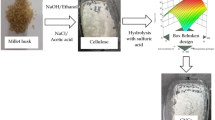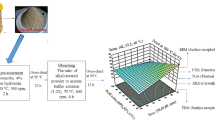Abstract
A statistical optimization of cotton cloth waste-based cellulose nanocrystal production was carried out using sulfuric acid hydrolysis and response surface methodology. The three independent variables, including sulfuric acid concentration (58–64 wt%), hydrolysis temperature (50–70 °C), and hydrolysis time (40–80 min) were selected by Box–Behnken design. The findings indicated that the quadratic polynomial models used to predict cellulose nanocrystal yield, crystallinity index, and average particle size were highly reliable, indicating strong relationships between the independent variables and the responses. The optimized conditions for acid hydrolysis were identified as 61.27 wt% sulfuric acid concentration, a hydrolysis temperature of 50 °C, and a hydrolysis time of 56 min. At these conditions, the experimentally highest cellulose nanocrystal yield and crystallinity index were 44.57 and 86.29%, respectively, while the smallest average particle size was 160 nm. The analysis of interaction effects indicated that the crystallinity index tended to increase under strong hydrolysis conditions, but the strong hydrolysis conditions caused a decrease in yield and average particle size. Moreover, the obtained cellulose nanocrystal properties met the required specifications, indicating cotton cloth waste is a prospective cellulose source for bio-nanomaterial production on an industrial scale. Besides, effective optimization measures can potentially curtail excessive costs in cellulose nanocrystal preparation.




Similar content being viewed by others
Availability of data and material
Not applicable.
References
Csiszar E, Kalic P, Kobol A, De Paulo Ferreira E (2016) The effect of low frequency ultrasound on the production and properties of nanocrystalline cellulose suspensions and films. Ultrason Sonochem 31:473–480
Csiszár E, Nagy S (2017) A comparative study on cellulose nanocrystals extracted from bleached cotton and flax and used for casting films with glycerol and sorbitol plasticisers. Carbohyd Polym 174:740–749
Danmaliki GI, Saleh TA, Shamsuddeen AA (2017) Response surface methodology optimization of adsorptive desulfurization on nickel/activated carbon. Chem Eng J 313:993–1003
Doan TKQ, Chiang KY (2022) Characteristics and kinetics study of spherical cellulose nanocrystal extracted from cotton cloth waste by acid hydrolysis. Sustain Environ Res 32:1–14
Dochia M, Sirghie C, Kozłowski RM, Roskwitalski Z (2012) Cotton fibres. In: Kozłowski RM (ed) Handbook of natural fibres. Woodhead Publishing, pp 11–23
Dong S, Bortner MJ, Roman M (2016) Analysis of the sulfuric acid hydrolysis of wood pulp for cellulose nanocrystal production: a central composite design study. Ind Crops Prod 93:76–87
Foo ML, Ooi CW, Tan KW, Chew IML (2020) A step closer to sustainable industrial production: tailor the properties of nanocrystalline cellulose from oil palm empty fruit bunch. J Environ Chem Eng 8(5):104058
Gong J, Li J, Xu J, Xiang Z, Mo L (2017) Research on cellulose nanocrystals produced from cellulose sources with various polymorphs. RSC Adv 7:33486–33493
Henrique MA, Neto WPF, Silvério HA, Martins DF, Gurgel LVA, Da Silva Barud H, De Morais LC, Pasquini D (2015) Kinetic study of the thermal decomposition of cellulose nanocrystals with different polymorphs, cellulose I and II, extracted from different sources and using different types of acids. Ind Crops Prod 76:128–140
Hou W, Ling C, Shi S, Yan Z (2019) Preparation and characterization of microcrystalline cellulose from waste cotton fabrics by using phosphotungstic acid. Int J Biol Macromol 123:363–368
Ju X, Bowden M, Brown EE, Zhang X (2015) An improved x-ray diffraction method for cellulose crystallinity measurement. Carbohyd Polym 123:476–481
Kargarzadeh H, Ahmad I, Abdullah I, Dufresne A, Zainudin SY, Sheltami RM (2012) Effects of hydrolysis conditions on the morphology, crystallinity, and thermal stability of cellulose nanocrystals extracted from kenaf bast fibers. Cellulose 19:855–866. https://doi.org/10.1007/s10570-012-9684-6
Karim M, Chowdhury ZZ, Hamid SBA, Ali M (2014) Statistical optimization for acid hydrolysis of microcrystalline cellulose and its physiochemical characterization by using metal ion catalyst. Materials 7:6982–6999
Le Normand M, Moriana R, Ek M (2014) Isolation and characterization of cellulose nanocrystals from spruce bark in a biorefinery perspective. Carbohyd Polym 111:979–987
Li R, Fei J, Cai Y, Li Y, Feng J, Yao J (2009) Cellulose whiskers extracted from mulberry: a novel biomass production. Carbohyd Polym 76:94–99
Lin N, Dufresne A (2014) Surface chemistry, morphological analysis and properties of cellulose nanocrystals with gradiented sulfation degrees. Nanoscale 6:5384–5393
Lu Q, Cai Z, Lin F, Tang L, Wang S, Huang B (2016) Extraction of cellulose nanocrystals with a high yield of 88% by simultaneous mechanochemical activation and phosphotungstic acid hydrolysis. ACS Sustain Chem Eng 4:2165–2172
Maciel MMÁD, Benini KCCDC, Voorwald HJC, Cioffi MOH (2019) Obtainment and characterization of nanocellulose from an unwoven industrial textile cotton waste: effect of acid hydrolysis conditions. Int J Biol Macromol 126:496–506
Merlini A, Claumann C, Zibetti AW, Coirolo A, Rieg T, Machado RA (2020) Kinetic study of the thermal decomposition of cellulose nanocrystals with different crystal structures and morphologies. Ind Eng Chem Res 59:13428–13439
Park S, Baker JO, Himmel ME, Parilla PA, Johnson DK (2010) Cellulose crystallinity index: measurement techniques and their impact on interpreting cellulase performance. Biotechnol Biofuels 3:1–10
Riba J-R, Cantero R, Canals T, Puig R (2020) Circular economy of post-consumer textile waste: classification through infrared spectroscopy. J Clean Prod 272:123011
Shaheen TI, Emam HE (2018) Sono-chemical synthesis of cellulose nanocrystals from wood sawdust using acid hydrolysis. Int J Biol Macromol 107:1599–1606
Shak KPY, Pang YL, Mah SK (2018) Nanocellulose: Recent advances and its prospects in environmental remediation. Beilstein J Nanotechnol 9:2479–2498
Shamskar KR, Heidari H, Rashidi A (2016) Preparation and evaluation of nanocrystalline cellulose aerogels from raw cotton and cotton stalk. Ind Crops Prod 93:203–211
Shankaran DR (2018) Chapter 14—cellulose nanocrystals for health care applications. In: Mohan Bhagyaraj S, Oluwafemi OS, Kalarikkal N, Thomas S (eds) Applications of nanomaterials. Woodhead Publishing, pp 415–459
Stanes E (2020) Lingering matter: materialities, temporalities and waste in clothes. In: The temporalities of waste. Routledge, pp 122–135
Tarchoun AF, Trache D, Klapötke TM (2019) Microcrystalline cellulose from posidonia oceanica brown algae: extraction and characterization. Int J Biol Macromol 138:837–845
Thambiraj S, Ravi Shankaran D (2017) Preparation and physicochemical characterization of cellulose nanocrystals from industrial waste cotton. Appl Surf Sci 412:405–416
Vanderfleet OM, ED Cranston (2020) Production routes to tailor the performance of cellulose nanocrystals. Nat Rev Mater 1–21
Wang Z, Yao Z, Zhou J, Zhang Y (2017) Reuse of waste cotton cloth for the extraction of cellulose nanocrystals. Carbohyd Polym 157:945–952
Xiao Y, Liu Y, Wang X, Li M, Lei H, Xu H (2019) Cellulose nanocrystals prepared from wheat bran: characterization and cytotoxicity assessment. Int J Biol Macromol 140:225–233
Xiong R, Zhang X, Tian D, Zhou Z, Lu C (2012) Comparing microcrystalline with spherical nanocrystalline cellulose from waste cotton fabrics. Cellulose 19:1189–1198
Yahya M, Chen YW, Lee HV, Hock CC, Hassan WHW (2019) A new protocol for efficient and high yield preparation of nanocellulose from elaeis guineensis biomass: a response surface methodology (RSM) study. J Polym Environ 27:678–702
Yao W, Weng Y, Catchmark JM (2020) Improved cellulose x-ray diffraction analysis using fourier series modeling. Cellulose 27:5563–5579
Acknowledgements
The authors are sincerely thankful to the Taiwan Ministry of Science and Technology (MOST) for financial assistance (Grand number: MOST-109-2221-E-008-023-MY2) and the Center for Advanced Instrumentation, National Central University, Taiwan, for providing analytical facilities to implement this research.
Funding
This work was supported by the Taiwan Ministry of Science and Technology (MOST).
Author information
Authors and Affiliations
Contributions
Kim Quyen Thi Doan-doing experiments, analyzing data, and writing the draft manuscript. Prof. Kung-Yuh Chiang-supervising the whole research and revising the manuscript.
Corresponding author
Ethics declarations
Conflict of interest
The authors declare they have no competing interests.
Ethical approval
This article does not contain any studies with human participants or animals performed by any of the authors.
Additional information
Editorial responsibility: Q. Aguilar-Virgen.
Supplementary Information
Below is the link to the electronic supplementary material.
Rights and permissions
Springer Nature or its licensor (e.g. a society or other partner) holds exclusive rights to this article under a publishing agreement with the author(s) or other rightsholder(s); author self-archiving of the accepted manuscript version of this article is solely governed by the terms of such publishing agreement and applicable law.
About this article
Cite this article
Doan, K.Q.T., Chiang, K.Y. Statistical optimization of cellulose nanocrystal from cotton cloth waste using sulfuric acid hydrolysis and response surface methodology. Int. J. Environ. Sci. Technol. 21, 5691–5704 (2024). https://doi.org/10.1007/s13762-023-05384-9
Received:
Revised:
Accepted:
Published:
Issue Date:
DOI: https://doi.org/10.1007/s13762-023-05384-9




